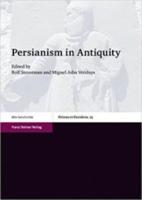
Steiner Verlag (2017) h/b 557pp £66.65 (ISBN 978351511382)
Images on Attic pots of Greek warriors vanquishing effeminate enemies in striped oriental clothing; parasols held by daughters of metics over Athenian girls acting as basket bearers in the Panathenaic procession; carinated silver bowls from 4th– 3rd C BC Egypt; attempts to legitimise the rule of a new dynasty by tracing its genealogy back to Persian nobles; Hasmonean rewriting of Judaea’s past to trace precedents for their main ideologies in Israelite history under Persian rule; the revival of the cult of Mithras; nostalgic references by Plutarch and Pausanias to the Achaemenid era when Hellenic identity was formed; a framework for the imperial propaganda of the Sasanian empire; feasting and hunting motifs in the art of a late 19th C Persia keen to forge a new national identity…
These are some of the various examples of Persianism presented in this substantial volume, which contains a collection of specialist papers originally presented at a conference in Istanbul in 2014 and dedicated to Professor Henk Versnel on the occasion of his 80th birthday. Its intended audience is primarily scholars involved in academic research on Persia and the history of Iran, but also those interested in the cultural dynamics of antiquity. The editors are keen to promote a deeper understanding of the interrelation between the cultures of East and West in the ancient world and broaden the traditionally Euro-centric outlook of ancient history.
The introduction offers a definition of the term ‘Persianism’ as ‘ideas and associations revolving around Persia and appropriated in specific contexts for specific (socio-cultural or political) reasons’ (p. 9), and emphasises that the reworking of the concept of ‘Persia’ in a variety of contexts has in fact wielded an influence far beyond that of the original empire of the Achaemenids. The editors argue that Achaemenid Persia, like Rome, was one of the most successful imperial powers of antiquity, and that its cultural sway can be compared to that of Classical Greece or China, forging such a potent ‘empire of the mind’ that even while Achaemenid Persia was still a historical reality, the idea of ‘Persia’ was already a deliberate construct.
The book is divided into three parts. Part One contains papers addressing the way Iranianism functioned under the Achaemenids, the Athenian perspective both in exchange of goods, ideas and vocabulary and in the construction of the Oriental ‘Other’, as well as the reception of Persia in later time periods: the influence of Western travellers via travel journals on the development of early-modern Iranian perceptions of pre-Islamic monuments, the revival of Achaemenid art in 19th C Persia, and the prominence of the empire in German historical philosophy. Part Two contains articles on Persianism in the Hellenic East: in Ptolemaic Egypt, among the Seleucid rulers, Mithradates Eupator of Pontos and the Hasmoneans in Judaea. Part Three concentrates on the use of the Achaemenid past in Roman Anatolia, in the reinvention of the cult of Mithras, in the writings of Plutarch, Pausanias, Ammianus Marcellinus and Josephus, and by a succession of Sasanian rulers.
The articles are in English with the single exception of one in German, and there are numerous black and white illustrations and diagrams as well as a detailed bibliography, although no index. The quality of the papers is varied on account of the number of different authors, and the volume as a whole would have benefited from more thorough proof-reading, but it amply fulfils its objective of offering a ground-breaking overview of why Persia was such an important symbol to construct meaning with and of providing food for thought about the concepts of ‘Greece’ or ‘Egypt’ to a wider scholarly audience, the theme of the interrelation of cultures, as the editors point out, being of particular relevance to the concerns of our contemporary world.
Claire Gruzelier
